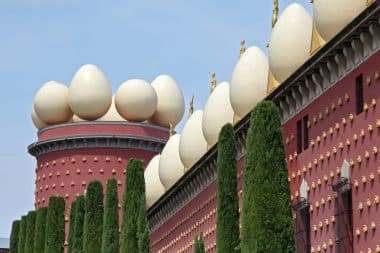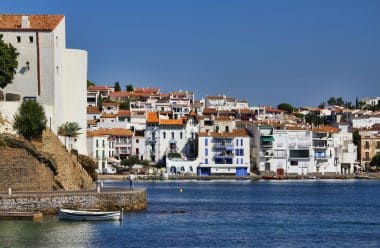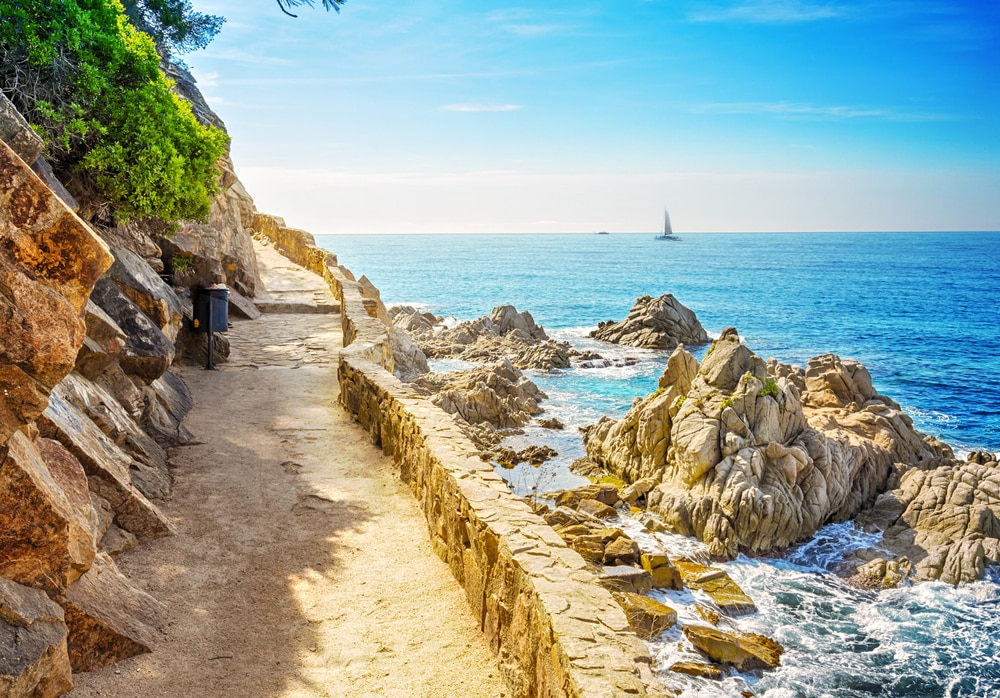With the crossing of the French-Spanish border La Jonquera, the region of Catalonia begins in the northeast of Spain and the Costa Brava stretches from Roses to Blanes for about 220 kilometers. It is a popular holiday region that has been growing steadily since the 70s. It is not only the Mediterranean climate that attracts holidaymakers again and again. The hospitality of the Catalans also contributed significantly to this. In the meantime, almost every smaller town maintains a well-run museum and the existing architecture and way of life is proudly presented. Beaches and streets are usually very clean, which also applies to campsites in general. Because it is precisely the high quality of the pitches that makes camping on the Costa Brava so attractive.
We have compiled the most popular places on the Costa Brava for you:
Figueres

This small town presents itself in typical Catalan style. Figueres does not impress with countless attractions. Because there is only one sight, but it has it all: the Salvador Dali Museum. Works by Dali are exhibited over several floors, which take many visitors to the limits of their perception. Like the picture-in-picture painting. The Dali Museum is unmissable. On the roof there are large and egg-shaped objects. In addition, the building and the surrounding area are very colorful and therefore very eye-catching. Even those who are difficult to reach for art will enjoy it here. However, a visit should be well prepared. During the holiday season, there is a strong rush of visitors in front of and in the museum. Of course, Figueres is influenced by Dali, but in some districts it shows the typical Spanish flair. Small and narrow alleys invite you to linger, while a few meters further on, imposing magnificent buildings and parks amaze the visitor.
Roses
This small coastal town is located at the foot of the Pyrenees and is the namesake for the entire region, the Golf de Roses. A circular arch facing the sea over several kilometres includes numerous small villages and campsites, which are particularly popular in summer. On balmy summer nights, the harbour of Roses and the beach promenade have the typical holiday flair. Roses offers its guests a beautiful city centre with numerous small shops. There is also an aqua park with numerous slides and water pools.
Golf de Roses
The elongated bay starts at Roses and ends at L ́Escala. A sandy beach runs along the entire route, where numerous beach bars are set up in summer. The Mediterranean Sea invites you to swim and numerous water sports enthusiasts will find dream conditions here. Access roads to the beach sections are available everywhere and parking spaces are often located directly near the beach. Only in a thunderstorm situation that builds up over the Pyrenees is caution advised. Then a storm situation can quickly occur.
Cadaquez

Somewhat hidden, the small town with its typical Spanish architecture is located on the other side of Roses. Until the 80s, it was mainly artists who were stranded here and shaped the flair of a relaxed lifestyle. If you are driving to Cadaquez, you should definitely take a break at one of the viewpoints. Because here there is an unobstructed and breathtaking view of the Costa Brava. The influence of Salvador Dali can be felt in the city itself and is also present in numerous places, as his residence was located a few kilometers from Cadaquez. Today it can be visited as a museum, although the Dalí Museum in Figueres is much more extensive. In Cadaquez, especially in summer, there is a lot to see and be seen. On the sheltered beach there are numerous restaurants and bars. The city center itself is characterized by the original way of life of the Spaniards and has its own flair, which is difficult to describe.
Girona
An initially inconspicuous city. But here you can find everything that has produced the architecture of Spain. In addition to imposing cathedrals and buildings, it is also the colorful houses on the Onyar River that runs through the city. Girona is of course also known for its airport, which is served by almost all European airlines. An impressive and imposing city in the hinterland of Catalonia.
Palamos
A small coastal town with a city centre designed for tourists. Especially in the evening, the harbour promenade with its beach shows itself in a friendly sea of lights. Palamos is known for its fish market and the surrounding bays.
Cap de Creus National Park
Access to the Cap de Creus National Park is from Cadaquez and requires safe driving. There is a lighthouse to marvel at, which marks the easternmost tip of the Iberian Peninsula. The national park is suitable for safe hikers.
Lloret de Mar
Everything is a bit louder and more crowded here. In Lloret de Mar, the party scene meets and celebrates life and itself on the long beach. If you love numerous hotels located directly on the beach, this is the place for you. The city center is of course very tourist-oriented, but this city is always fun.
Pyrenees
Even if the Spanish mountain range is not directly connected to the Costa Brava, it is always present. If there is an unbearable humidity on the Costa Brava, due to the south wind, a trip to the mountains is a good idea. The roads are all well maintained and there are numerous viewpoints.


